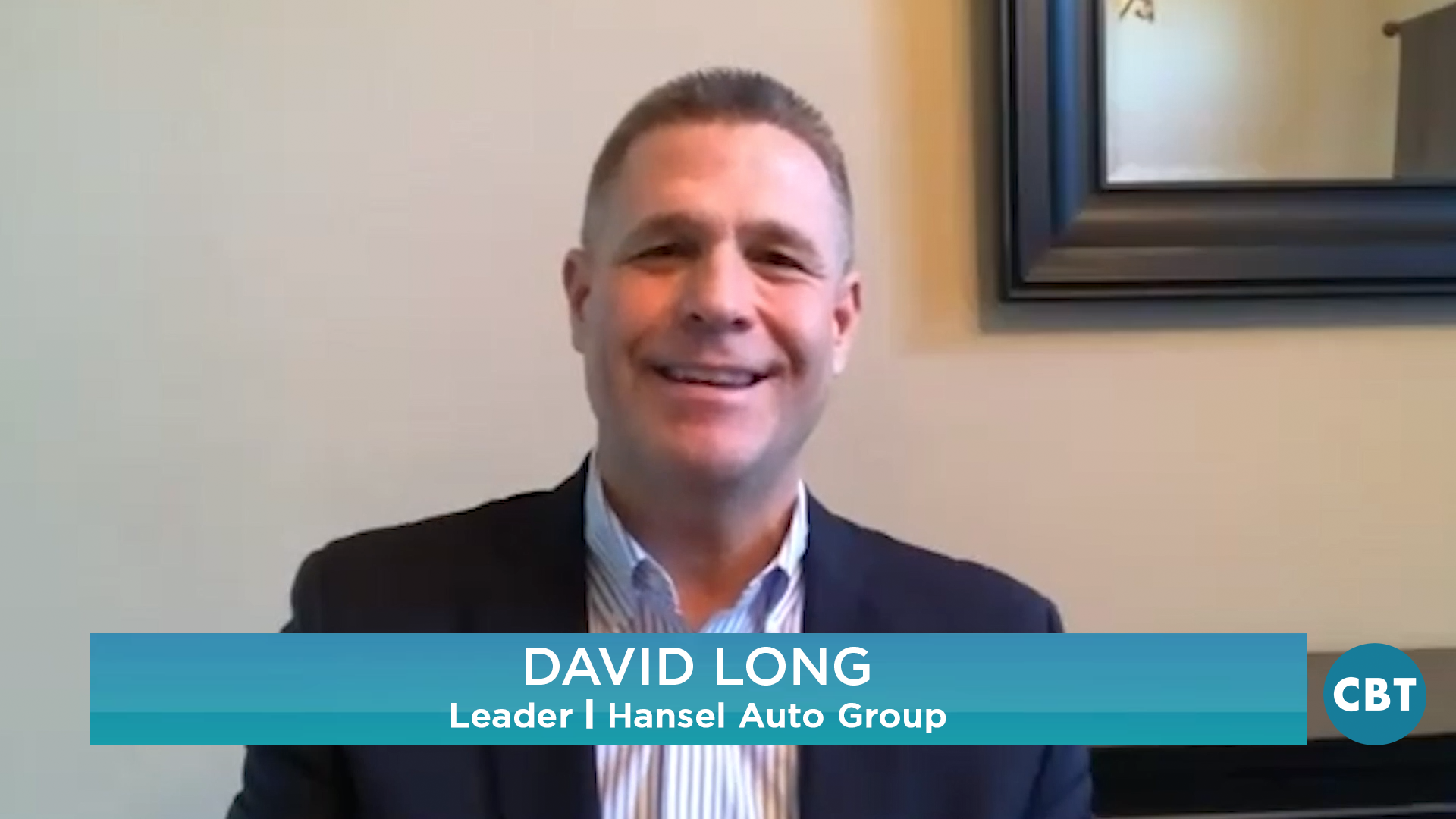Here to discuss your return on time, and how dealers can increase efficiency as well as reduce turnover, is David Long, a veteran of the auto retail industry who has held top positions at several high volume dealer groups including Hansel Auto Group, located in California’s Bay area.
Related: The Future of Vehicle Shopping at the Push of a Button – David Long, Retail Automotive Expert
Jim Fitzpatrick: Hi everyone. Jim Fitzpatrick with CBT News. Thanks so much for joining me today. Today I’m excited to talk to Mr. David Long. He’s a veteran auto retail executive and leader over at Hansel Auto Group in the position of Executive General Manager. Thanks so much David, for joining us once again on CBT News.
David Long: Jim, it’s good to be here with you. Always like spending time together.
Jim Fitzpatrick: How’s your 2020 going so far?
David Long: We started out fairly strong.
Jim Fitzpatrick: Good. Came off of a great 2019 in the auto industry. 17 million SAAR, which is great. That wasn’t the retail SAAR per se, but all indications are that, or I should say that people that we’re talking to that are in the position of forecasting the future, tell us we’re probably going to be somewhere between 16.6 And maybe 16.8 for a SAAR. We might be off a little bit on new cars but used cars, will be picking up throughout the year and actually finished better than we did in 2019. Having said that, and I know that you’re kind of an efficiency nut, it’s really about running the dealerships as efficiently as we can. And I know you and I have talked before about the inefficiencies that happen in the variable side of the business. You’ve got a term that’s ROT, return on time. Talk to us a little bit about your philosophy there and what that means.
David Long: Okay. Jim, I had an absolute defining moment when I was digging into my variable or my fixed operations and identifying unapplied time, identifying service efficiencies. And I thought, wow, this is my 30th year and I’ve never once stopped to consider sales efficiency. And I started to put a pen to paper on number of salespeople times days worked, times hours in the day. And it was a staggering realization is if I started to measure the return on time on the sales side, like I do return on time on the service side, I could have a completely different business.
Jim Fitzpatrick: Right. That’s right. What do you say to the dealers that say, “Well, it’s not exactly the same, you can’t really measure it like that. It’s different with techs and their performance than it is with salespeople.” What’s your take on that?
David Long: I could understand that perspective and I think there has to be a certain level of benchmarking for everything. For instance, if I have 20 salespeople working eight hours a day, I have $2,400 worth of payroll. I think I should know if I’m sitting down and writing a check at the end of the day for $2,400, what sort of return I had on not only the time invested but the payroll invested. That’s what I would invite any dealer to look at.
Jim Fitzpatrick: When I was on the showroom floor many moons ago, it was almost looked at as kind of a penalty that if you weren’t with a customer and you weren’t out selling a car, then the manager would grab you and say, “Hey, here’s what I want you to do. Here’s a list, start calling.” It was almost like it was looked upon as kind of a penalty for not being busy. Does that make sense?
David Long: It really does. It’s punitive. One of the things that I was mind-boggled by, so I saw one of my managers, and we have a lot of managers, we have a lot of rooftops, hand a list to five different people. And I watched them walk back to their desk and it was really interesting because they sat down, knowing the task at hand and they set the list in front of them and then they went online and did something completely different. As I started to unpack that, I started to realize that yes, they have the list. Yes, they know what to do. But guess what they don’t have? They don’t have the skillset to get it done.
Jim Fitzpatrick: That’s right. That’s right.
David Long: If I’m not measuring, think about this. If I’m not truly measuring the amount of outbound contacts to appointments, I don’t really know if they have the skillset to continue to make those calls.
Jim Fitzpatrick: With as long as we’ve been doing this in the industry for the last 100 years, selling cars, you would think that we would have come up with a plan by now that says when you’re hired, and many dealerships I’m sure, have done just that so save the emails. But there’s a lot of dealerships that haven’t, they just hire salespeople and put them into maybe a one-week training course or what have you and then cut them loose on the showroom floor to see what they’re made of before they spend any more time and resources on that individual. And hence the reason that you’ll hear people say, “Well, if you want three, you got to hire 10.” What are we doing? Where is that the case in any other industry? Could you imagine the pharmaceutical industry saying, “If you want three pros, you’ve got to hire 10.” They would say, “No, if you want three, you got to hire three and support them and train them and teach them.”
David Long: Can you imagine as an adult in the working world, trading a full day, a full week or a full month of your life and really having nothing tangible to show for it? It’s really tough. I kind of, I would invite anybody that’s listening to this and I know that there are times where I’m like the nutty professor. And why do you think that way? How many hours, clock hours does each associate on your team work per car deal? Is that a valuable KPI do you think?
Jim Fitzpatrick: Yep.
David Long: It’s an interesting number when you see that some people have to work 36 hours, clock hours, not days, 36 clock hours to sell a car. Where the most efficient salespeople can work six or seven clock hours to sell a car.
Jim Fitzpatrick: Right. That’s right.
David Long: But if you don’t know that, how do you improve on that? And then the layer below that is if you know how many hours it takes somebody to sell a car or work, worked hours to sell a car, wouldn’t it then stand to reason that you should also know how many clock hours it takes for somebody to go on a demo drive?
Jim Fitzpatrick: That’s right. At your group today at Hansel Auto Group, when somebody comes into the industry, do you hire people that don’t have any experience?
David Long: We do. That’s generally all we hire. Would we hire somebody that has experience? Absolutely. But we generally hire people with no experience.
Jim Fitzpatrick: Walk me through that, the first 30 days of that new recruit’s life at your store.
David Long: I’m super fortunate to have a human resource team that has helped us establish an onboarding process that really makes that new hire feel special and celebrated. When they show up, it’s not like, “Hi, welcome too. Are you here to see anybody in particular?” There’s a rhyme and a reason when they show up, there’s almost a welcoming committee. There is a welcoming committee. And it’s multiple rooftops so they’ll get sort of embraced by the entire company, parts, service, sales when they start.
Jim Fitzpatrick: It’s a full orientation.
David Long: Absolute structured timeline for every single thing in our process, whether it be online training, phone training, consumer training, product training, walk around training. It’s all right there when they start. There is no show-up and sit over there and put you on a computer and hope you get through your factory testing while I’m busy being a manager.
Jim Fitzpatrick: Right, right. And how long before that individual is actually working with customers one on one?
David Long: This is going to be different, Jim. This is, I am a firm believer because I was an incredibly slow learner and still am, that everybody’s learning curve is different. While a salesperson is new, they buddy or pair with another salesperson that is fundamentally sound in his daily tasks and activities and his ability to interact with customer. You know what? Sometimes the person is able to break free and interact with a guest in the first couple, three weeks. Sometimes it takes three months. For me, there is no hard, you have to be ready to interact with consumers by day 27. You have to be ready when you’re ready.
Jim Fitzpatrick: Okay. That is different because sales, usually dealers or GMs want a set number of days or a number of weeks to say, “Okay, we now have that new recruit put he or she out on the showroom floor. Let’s see how they interact with customers. See if they can close some deals or at least bring some deals to the desk for the managers to help close them or what have you. And let’s get that person up and running.”
David Long: I think that’s where we lose a lot of people. We may think they’re ready and the clock may say they’re ready and the calendar days may say they’re ready. Hey, they’re terrified. Then we kick them into the deep end and what do they do?
Jim Fitzpatrick: Yep. They drown.
David Long: They drown.
Jim Fitzpatrick: That’s right.
David Long: They drown. They’re terrified. They look for reasons why this isn’t the industry for them, and that’s when people start to quit. Another very kind of interesting thing, three day, no sale report. Have you heard of that?
Jim Fitzpatrick: I have heard of that. Is that where if they’ve done no sales in three days?
David Long: Yeah. There’s, I think there’s a couple schools of thought to that. Three day, no sale report could be used as a sort of a battering ram to tell somebody they stink and they better get to work. My feelings are, when somebody goes three full days without selling a car, I don’t care how good you are. I can remember, Jim, selling 30 cars in a month, 40 cars in a month, and then I’d go three days without selling a car and guess what I thought?
Jim Fitzpatrick: Yeah, you’re a bum.
David Long: I thought that the last 10 years were luck. My mind started to tell me things that just weren’t so. What we do with the three day no sale report, when somebody shows up on that third day, it’s circle the wagons. It’s let them know that we are absolutely going to make them a car deal today. All they need to do is get in front of somebody and we’ll take care of the rest. And the best time to sell a car, as we all know, is after you’ve sold a car.
Jim Fitzpatrick: Right after you’ve sold a car. That’s right. I was one of those salespeople that didn’t do anything until the 15th of the month. And then from the 15th to the 30th, I’d sell 15 cars. It was like a car day and I was kind of cocky that way. And I said, “Well I can always pull the month out.” Looking back now, could you imagine if I got going mentally on the first of the month and carried it all the way through to the 30th? And I know that I’ve worked with other salespeople as a manager and GM before where that was the case, where they just were like, “Hey, I’m just not, my head’s not in the game until about the 10th to the 15th and then I go for it.” It’s crazy.
David Long: And can you imagine if you had a sales manager or general manager that pulled you in at the end of the day and let you know how much he cared about you and your return on that day’s time? Did you win the hour? Did you win the day? What can we do to make sure tomorrow is a winning hour or day?
Jim Fitzpatrick: Interestingly.
David Long: Different than your first two weeks?
Jim Fitzpatrick: Yeah, no question. Interestingly, I was still taking ups that came in the door or maybe phone ups that called in at the time. And it was amazing. I look back down, I’m like, wow, how many people did I blow out? Buyers did I blow out just because my mindset was, I’m not going to do anything really until about the 10th or the 15th of the month. I was the one that was convinced the sale wasn’t going to happen, not the customer. Those customers went to other dealerships I’m sure that same day and took delivery of a vehicle.
David Long: Not to put you on the spot, but how long ago was that? What year? Was it when we were with AutoNation?
Jim Fitzpatrick: You’re killing me. I can’t, you’re breaking up on me. I can’t. No, I’m kidding. That was in the early eighties.
David Long: Let’s just say. Oh, so the eighties.
Jim Fitzpatrick: If you’re going to push me, it was 1982.
David Long: 82?
Jim Fitzpatrick: Don’t make it like I’m that much older, okay?
David Long: Holy mackerel. 82. You’re a lot older.
Jim Fitzpatrick: They had cars in 1982?
David Long: You look good.
Jim Fitzpatrick: Exactly.
David Long: Think about this, today it’s a completely different ballgame.
Jim Fitzpatrick: Totally different.
David Long: We still have those salespeople that are second half salespeople. The only difference is…
Jim Fitzpatrick.: I’m sure.
David Long: Back then, if you sold 20% of the people you’re greeted, you were doing a great job.
Jim Fitzpatrick: Oh, no question.
David Long: Today, the zero moment of truth has buyers that we turn into shoppers.
Jim Fitzpatrick: That’s right. And we know these things, execution is everything, great ideas are phenomenal, but execution really is everything. And what you’re talking about here today is holding salespeople accountable for their time and giving them a work plan, giving them a structure and then holding them accountable to make sure that it’s been executed properly. The execution goes from the manager to make sure the work’s done. And then of course to the salesperson to make sure that their task is done. And guess what happens at the end of the day? Sales. Sales happen.
David Long: They do.
Jim Fitzpatrick: Yep. Every time.
David Long: One layer beneath that is timeframe.
Jim Fitzpatrick: That’s right.
David Long: It’s the structure, the discipline and the timeframe for holding people accountable.
Jim Fitzpatrick: That’s right. That’s right.
David Long: I call it the three-period approach, Jim. Do you follow hockey at all?
Jim Fitzpatrick: I don’t, I’m not a huge hockey fan.
David Long: I’m not either. I’ve never even skated a day in my life, but I do like the concept of breaking down the day in three periods. End of the first period, did we win that period? If we have 10 salespeople schedule on and you have four hours invested in that particular day or three, however you breakdown your periods. Did that three hours times 10 people, that’s 30 hours of payroll. Did you win those 30 hours? I would want to know if I was managing a hockey team.
Jim Fitzpatrick: That’s right.
David Long: Did you score a goal? You set an appointment? What kind of effort do you have to show for 30 hours of work?
Jim Fitzpatrick: I know, I know. Incredible. Well, David Long.
David Long: I get pretty excited.
Jim Fitzpatrick: Yeah. Thank you so much for joining us. The executive general manager, Hansel Auto Group. I know that everyone listening knows that group. You guys have been out there, for a while and it’s a great auto retailer. You guys are doing great work. Some great things. But so I want to thank you so much for joining me, David. Your visit on CBT is always very insightful and our viewers get a lot out of it.
Jim Fitzpatrick: For those of you that are thinking how to turn 2020 into a huge profitable year, it starts by holding your salespeople and your managers accountable. What are they doing every single hour of every single day? And if the answer is you don’t know, then you’re in the weeds. You’re in hot water. Again, David, thank you so much. We’re going to see out at NADA in just a week or so. What is it? Next week I guess.
David Long: I’ll be there the 13th.
Jim Fitzpatrick: Good. I will be there on the 12th. We’ve got some interviews that we’re doing prior to the NADA convention, so we’ll see. Come out and stop by the booth.
David Long: Good talking to you. I’ll see you at NADA. Have a great day.
Jim Fitzpatrick: That’d be great, man. Thanks so much.









